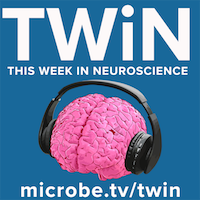TWiN explains how psychedelic drugs such as LSD, psilocybin, and MDMA, which are being explored for treating a wide range of neuropsychiatric diseases, reopen the social reward period for critical learning.
Vivianne explains how early in Alzheimer’s disease, the brain attempts to counteract the increased excitatory drive caused by amyloid deposition, and that melanin-concentrating hormone, produced during sleep, is involved in this protective response.
Tim takes TWiN through two studies on the role of dopamine: that syllables are natural units of spontaneous behavior used by the brain to structure action, and that mesolimbic dopamine release conveys causal associations but not reward prediction errors, thereby challenging the dominant theory of reward learning.
Junjie from Jason’s lab joins TWiN to discuss the observation that the cell gene PNMA2 encodes non-enveloped virus-like capsids that induce autoantibodies which underlie paraneoplastic syndrome.
TWiN explains the finding that immunity to commensal bacteria promotes sensory neuron regeneration via the cytokine interleukin-17A.
TWiN answers listener questions about Alzheimer’s disease, glaucoma and the microbiota, Dravet’s Syndrome, schizophrenia, brain development, and chips implanted in the human brain.
Jason and Tim review the use of an implanted chronic deep brain sensing and stimulation device to carry out biomarker-driven closed-loop therapy that resulted in a rapid and sustained improvement in depression.
TWiN explains how central nervous system resident macrophages known as microglia coordinate cellular interactions during spinal cord repair in mice.
TWiN describes how neurotropic viruses leave the brain via meningeal lymphatic vessels located dorsally and basally beneath the skull.
TWiN reveals how oligodendrocytes enhance axonal energy metabolism by transcellular delivery of a protein, SIRT2, that deacetylates mitochondrial proteins.

